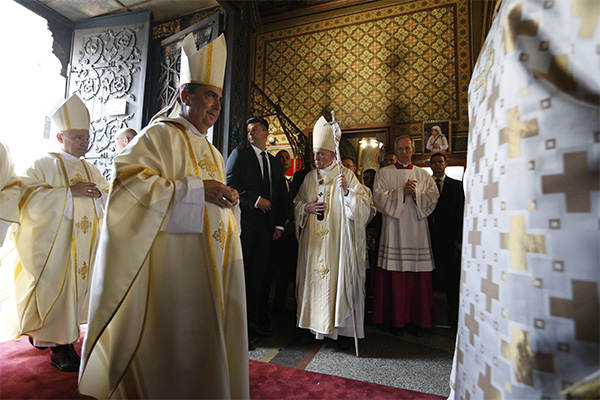
By Claire Giangravè
BUCHAREST, Romania (Crux) – In a jam-packed Saint Joseph Cathedral in Romania on Friday, Pope Francis encouraged the local church to embrace a culture of encounter while giving a shout-out to women in the country.
“Contemplating Mary enables us to turn our gaze to all those many women, mothers and grandmothers of these lands who, by their quiet sacrifices, devotion and self-denial, are shaping the present and preparing the way for tomorrow’s dreams,” the pope said in a homily based on a meeting between Elizabeth and Mary in the Gospel.
“Theirs is a silent, tenacious and unsung sacrifice; they are unafraid to ‘roll up their sleeves’ and shoulder difficulties for the sake of their children and families,” he added.
Aboard the papal plane from Rome, Pope Francis greeted Mexican journalist Valentina Alazraki with whom he had a long interview published May 28. He told the reporter that he had been touched by the story of Rocío, a murdered Mexican woman, and reinforced the importance of eliminating violence against women.
Starting at the age of 15, 30 percent of women in Romania have experienced physical or sexual violence and only 23 percent reported the case to the police, a 2014 European Union Agency for Fundamental Rights survey found. These numbers are not dissimilar from other European countries.
“Our Lady knows what it means to walk uphill, she knows what it means for us to walk uphill, and she is our sister at every step of the way,” Pope Francis told faithful.
Mary’s walking “uphill” is not dissimilar from the challenges that the Catholic community in Romania had to face in the 20th century following decades of Nazi and Communist control and extensive anti-religious persecution.
In Pope Francis’ telling of the pregnant Mary’s meeting with Elizabeth, also pregnant with John the Baptist, their encounter is a moment where “young and old meet, embrace and awaken the best of each.”
Their meeting, he said, is a symbol for the “culture of encounter, where no one is discarded or pigeonholed, but all are sought out, because all are needed to reveal the Lord’s face.”
Yet, the culture of encounter can get trickier when it comes to relations between different religions, especially if the past has not always been one of friendship and dialogue. In the Orthodox-majority country of Romania, Catholics represent only four percent of the population divided between Roman and Eastern rite denominations.
Under the communist regime, the Catholic minority suffered persecution as the state attempted in 1948 to incorporate the Greek Catholic minority into the local Orthodox church.
Since then religious tensions have eased, but in a November interview Archbishop Ioan Robu of Bucharest, president of the Romanian bishops’ conference, said that “relations between Greek Catholics and Orthodox are living a sort of winter.”
Pope Francis encouraged Catholic faithful in the cathedral to put aside old resentments and anger and instead attempt to “foster encounter and communion.”
“In the Church, when different rites meet, when the most important thing is not one’s own affiliation, group or ethnicity, but the people who together praise God, then great things take place,” he said.
“Faith wavers when it just floats along in sadness and discouragement. When we live in mistrust, closed in on ourselves, we contradict the faith,” the Holy Father added, calling Romanians to be inspired by the “saints-next-door, who showed us the way.”

Women and men need to be made equal partners in our world-building mission.